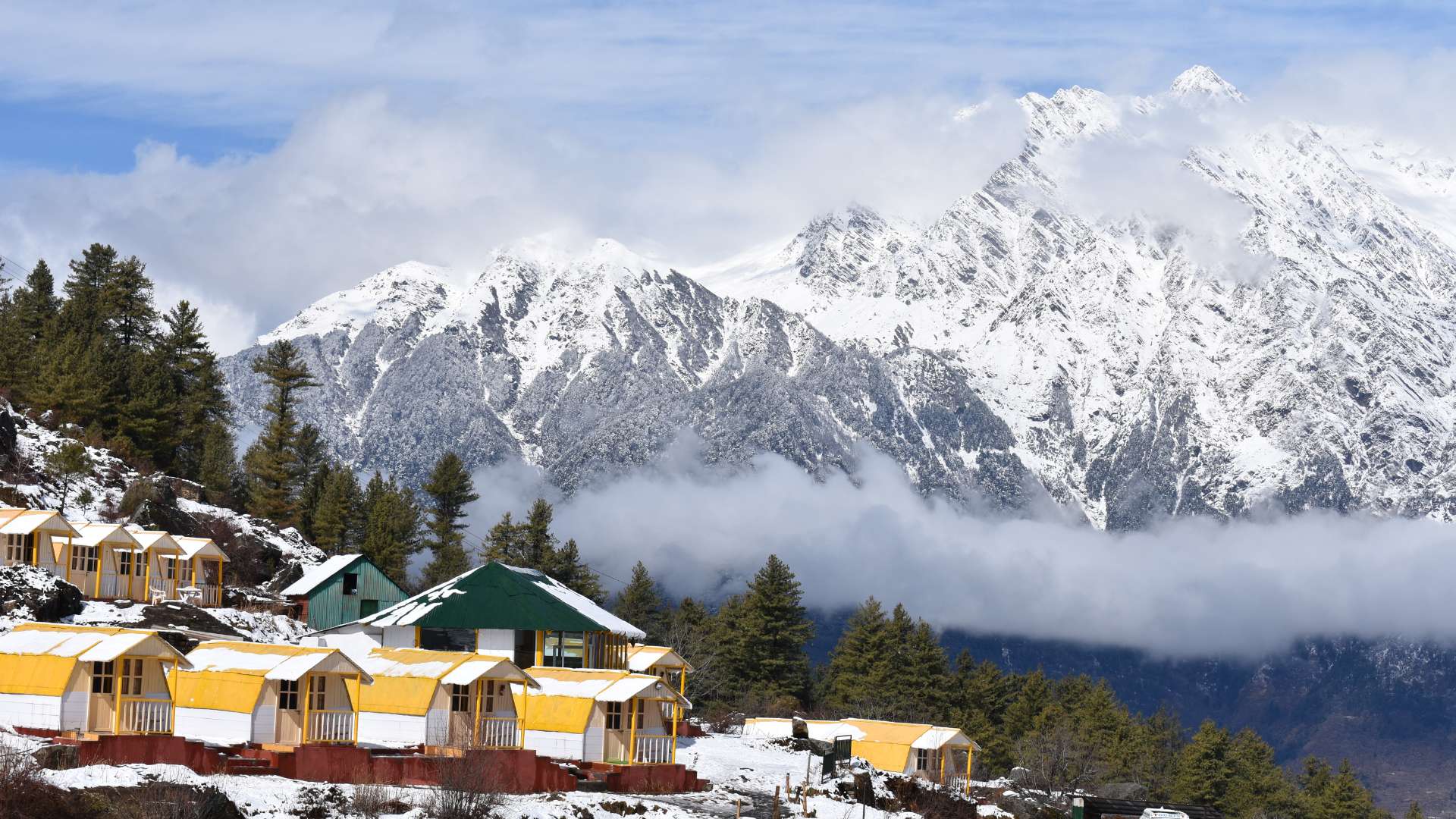Table of Contents
ToggleHave you ever walked into a city and felt like you were stepping into a living epic? Ayodhya, resting serenely on the banks of the Saryu River, invites you into more than just temples and ghats and it draws you into timeless tales, sacred echoes, and spiritual serenity.
As you explore, you’re not merely sightseeing; you’re walking through stories etched in stone and whispered in the wind. From the divine whispers of Shri Ram’s birthplace to the soulful silence of ancient tombs, Ayodhya offers you a journey for the spirit, mind, and senses.
Let’s begin your soul-soothing adventure through the top 10 things to do in Ayodhya, each offering a tale to tell, a moment to live, and a memory to cherish.
Best Things to Do in Ayodhya
1. Shri Hanuman Garhi Mandir
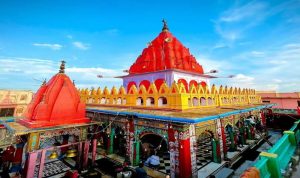
Image – Source
As you ascend the steep stone steps towards Shri Hanuman Garhi Mandir, the rhythmic chanting of “Jai Bajrang Bali” echoes through the air, guiding your steps like a devotional breeze.
This 10th-century temple sits on a slight elevation, almost as if Lord Hanuman himself is keeping vigil over Ayodhya. The moment you reach the top, you’re greeted by vibrant orange flags fluttering against the blue sky, a view that feels both powerful and peaceful.
Historically, this temple has been the faithful protector of the sacred city, believed to house a child-like idol of Hanuman seated in his mother’s lap.
As you step inside, the aroma of incense mingles with marigolds draped over the idol, and you’ll feel an energy that’s warm, inviting, and deeply rooted.
The air hums with the devotion of countless pilgrims, and for a moment, your heart feels as light as the ghee-lit lamps that flicker all around. The ambience is intimate and yet cosmic, making your visit not just a darshan, but a dialogue with faith.
2. Shri Ram Janam Bhumi Nyas
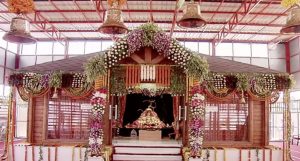
Image – Source
The moment your feet touch the grounds of Shri Ram Janam Bhumi Nyas, there’s a sense of reverence that settles in your chest.
You’re not just entering a location you’re entering a chapter of history revered by millions. Surrounded by massive security and bustling pilgrims, the atmosphere feels charged, yet serene, like standing in a silent conversation between centuries.
Believed to be the very birthplace of Lord Ram, this site is deeply spiritual and politically symbolic. As you walk along the carefully guided pathway, you pass through a corridor of devotion, chanting priests, folded hands, and eyes brimming with tears of joy.
The architectural grandeur of the new Ram Mandir structure emerging against the backdrop adds layers of pride, patience, and passion.
Inside, your gaze falls on Ram Lalla, radiant in gold adornments and divine grace. The air carries the scent of sandalwood, the flicker of sacred lamps dances on walls, and you feel the pulse of a nation’s belief. It’s more than a visit, it’s a homecoming of your soul to its roots.
3. Saryu Ghat
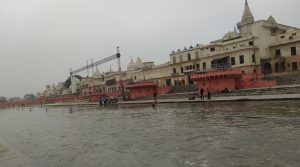
Image – Source
As the sun begins to dip, you find yourself by the banks of the sacred Saryu River, where soft hues of dusk melt into the water’s gentle ripples. Saryu Ghat isn’t just a riverside, it’s a theatre of rituals, where time flows as seamlessly as the river.
The evening aarti here is a symphony of bells, chants, and countless diyas lighting up the water like floating stars. Historically, this river has witnessed sages, saints, and seekers, its currents carrying tales of Ramayana and redemption.
You sit quietly among saffron-robed priests, watching them raise flaming aartis skyward, their reflections shimmering like gold across the water.
The air smells of camphor and jasmine, and you can feel the warmth of sacred fire on your face, even from a distance. As you close your eyes and absorb the rhythmic chanting, there’s a feeling that you’re not alone.
Here, by the Saryu, you sense the universe listening, breathing with you. It’s a moment of emotional surrender, both humbling and healing.
4. Kanak Bhawan
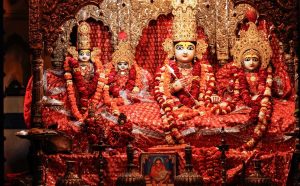
Image – Source
Tucked within the lanes of Ayodhya’s heart, Kanak Bhawan glows like a royal secret waiting to be discovered. As you walk through its ornate gates, a sudden burst of colour, turquoise domes, gold-encrusted walls, and intricate paintings greets you. The palace feels less like a museum and more like a vibrant hymn frozen in architecture.
This treasured temple-palace was a gift to Sita from Queen Kaikeyi after her wedding to Lord Ram, and every corner reflects joy, celebration, and love. As you explore the inner sanctum, you find richly adorned idols of Ram and Sita seated side by side, exuding the kind of intimacy and warmth that tugs at your heart.
You’ll hear devotional songs echoing gently through the marble corridors, and the scent of sandal and rosewood lingers in the air. The entire space feels like a living celebration timeless yet personal. In this divine dwelling, you’re not just a tourist; you’re an honoured guest at a celestial wedding still alive in spirit.
5. Shri Nageshwar Nath Mandir
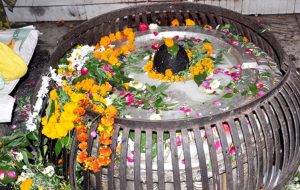
Image – Source
As you step through the towering gateway of Shri Nageshwar Nath Mandir, the city’s noise falls away like leaves in a breeze. The temple, wrapped in white stone and ancient carvings, stands dedicated to Lord Shiva and his serpentine emblem Nageshwar. The aura here is different, less celebratory, more meditative.
This temple, believed to have been built by Kush, Lord Ram’s son, holds deep historical reverence. Locals believe it was Kush’s tribute to Lord Shiva after a divine vision involving a Naga princess. Inside, the sanctum is cool and dim, with a softly glowing Shiva Lingam at its heart. Priests chant ancient mantras as the conch sounds mark every turn of prayer.
The scent of bel leaves and camphor floats in the air. You might even hear a temple bell ring sharply, echoing like a call to look within. Here, every step feels sacred, every sound a whisper from the past. It’s a place where the cosmic and the earthly shake hands in silent communion.
6. Raj Dwar Mandir
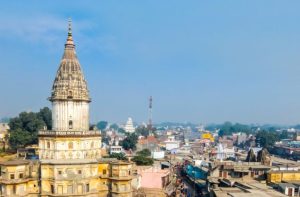
Image – Source
Hidden among Ayodhya’s quieter quarters, Raj Dwar Mandir emerges like a dream you almost forgot you had. The approach to this temple is peaceful, flanked by narrow streets where time seems to move slower. As you reach the massive, majestic, and carved with ancient detail, you realise why it’s named the “Royal Gate.”
This temple holds special reverence as the symbolic entrance to Ayodhya’s spiritual legacy. Locals believe it represents the threshold where divine energy first entered the city through Lord Ram. You cross into the temple and find yourself surrounded by serene idols and quiet courtyards bathed in golden morning light.
The sanctity of the place is palpable. Birds flutter between arches, temple bells toll softly, and the stone under your feet feels worn by centuries of barefoot devotion. The simplicity of this temple is its strength; it doesn’t demand awe, it earns it. You walk out not just feeling blessed but gently reminded of your own humble place in the larger spiritual mosaic.
7. Military Mandir

Image – Source
Approaching the Military Mandir, you’re struck by its uniqueness; it stands out not through extravagance, but through its soul. Draped in the colours of the Indian flag and adorned with portraits of brave martyrs, this temple offers you a poignant blend of national pride and spiritual faith.
This is no ordinary temple. Built in honour of India’s armed forces, it houses deities like Ram and Hanuman alongside images of soldiers who laid down their lives for the nation. You walk past rows of army boots, helmets, and regimental insignias turned into sacred offerings. Each step here is a salute wrapped in prayer.
You feel an unusual mix of devotion and patriotism, especially when you hear the soft tunes of the national anthem playing through temple speakers. The incense here smells of both reverence and resolve.
The environment instills pride in your veins and compassion in your heart. It’s a place where you don’t just bow your head in prayer, you lift it in pride.
8. Shree Ram Lala Devasthanam Temple
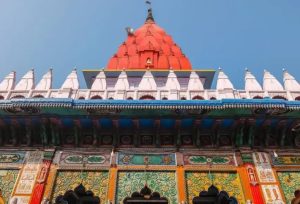
Image – Source
Stepping into the Shree RamLala Devsthanam Temple, you’re drawn first not to grandeur, but to innocence. The idol of Ram as a child, tiny, divine, and radiant, instantly pulls at your heartstrings. There’s something humbling about standing before a deity not in heroic stature, but in playful infancy.
This temple is part of the larger Ram Janmabhoomi complex, yet it holds a distinct intimacy. Historically significant and emotionally moving, the site reminds you that every divine journey begins in a cradle. The temple glows softly under golden light, with temple bells adding their melody to the air heavy with marigold and sandalwood.
As you peer into the sanctum, the face of RamLala gleams with innocence, framed by silver decorations and bright garments. Pilgrims weep quietly, parents whisper hopes, and the temple seems to listen. It’s a place where faith isn’t loud, it’s soft, warm, and whispering through the folds of every prayer.
9. Tulasi Smarak Bhavan

Image – Source
As you enter Tulasi Smarak Bhavan, a profound calm seems to blanket the space. This cultural and spiritual centre pays tribute to Goswami Tulsidas, the revered poet-saint who authored the Ramcharitmanas. You feel as though you’ve walked into his mind, with walls lined by verses and a gentle scent of old paper and incense lingering in the air.
Built in his honour, the Bhavan hosts regular recitations and spiritual talks, drawing seekers from all corners. As you step into the auditorium, you might hear soft chants resonating from a corner, each word breathing life into the epic of Ramayana. The on-site library beckons with its rare manuscripts, each shelf a quiet guardian of centuries-old devotion.
The light filters in softly through latticed windows, warming the wooden benches and casting shadows that feel like time slowing down. The energy here is one of reflection, more inward than outward. You leave the space feeling not just more informed, but deeply connected to the literary soul of Ayodhya.
10. Tomb of Bahu Begum
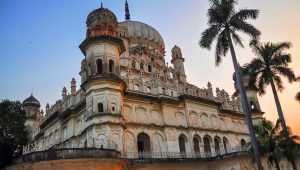
Image – Source
Leaving the sacred lanes behind, you approach the elegant solitude of the Tomb of Bahu Begum. Rising gracefully against the skyline, the structure is a testament to Mughal-era artistry in a city ruled by spiritual tales. It offers you a pause, a place where history breathes through silence, not song.
Constructed in 1816 in memory of the queen of Nawab Shuja-ud-Daula, this tomb is one of the tallest structures in Ayodhya. As you step closer, its octagonal base and intricate jali work reveal the finesse of Indo-Islamic architecture. The coolness of the stone beneath your hand contrasts with the soft sunlight pouring onto the carved dome above.
Inside, there’s no idol, no ritual, just quietude. Birds flutter through broken arches while the wind whistles softly through corridors. It’s a different kind of sacredness, one born of memory and mourning. Here, you’re not guided by belief but by beauty, and the realisation that Ayodhya, while soaked in divinity, is also layered with regal grace and timeless elegance.
Conclusion
As you journey through Ayodhya, you realise it’s more than a city, it’s a confluence of devotion, mythology, and living tradition. Each site tells a story that transcends time and language. From the fiery faith at Hanuman Garhi to the poetic calm of Tulasi Smarak Bhavan, Ayodhya holds space for your every spiritual longing.
You’ve wandered the ghats, stood before idols of gods, heard ancient prayers float on the river breeze, and walked into royal tombs. And somehow, amidst the chants and the silence, you’ve found a part of yourself. This city doesn’t just invite you to explore, it invites you to belong.
So pack your spirit of wonder, and let Ayodhya write a verse in your soul’s travel diary. Your divine chapter awaits.
FAQs
What is the best time of year to visit Ayodhya?
The ideal time to visit Ayodhya is between October and March when the weather is cool and pleasant. These months also align with key festivals like Diwali and Ram Navami.
Is Ayodhya safe for solo travellers and families?
Yes, Ayodhya is generally safe. The locals are helpful, and there’s a visible police presence near major temples and ghats. It’s a peaceful city rooted in spiritual tradition.
How many days should I spend in Ayodhya?
Two to three days are sufficient to explore the main temples, ghats, and cultural landmarks at a relaxed pace without rushing your experience.
Can non-Hindus visit all temples in Ayodhya?
Most temples welcome visitors of all faiths, though some sanctums may restrict entry during special rituals. It’s always respectful to ask or observe signs at entrances.
Are there river cruises or boat rides on the Saryu River?
Yes, especially around Saryu Ghat, you’ll find small boat rides available during sunrise and sunset. They offer a peaceful way to experience the river and its spiritual ambiance.
What kind of food can I expect in Ayodhya?
Ayodhya offers a mix of North Indian vegetarian cuisine with a focus on sattvic meals. You’ll find delicious kachoris, puris, halwas, and refreshing milk-based drinks near temple areas.
Is photography allowed at the main temples and ghats?
Photography is allowed in most public areas, but it’s restricted inside sanctums and during aarti ceremonies. Always check with temple staff before taking pictures.
Disclaimer
India Travel App does not own the above images used in this blog; the copyrights of those images belong to the respective owners only.





